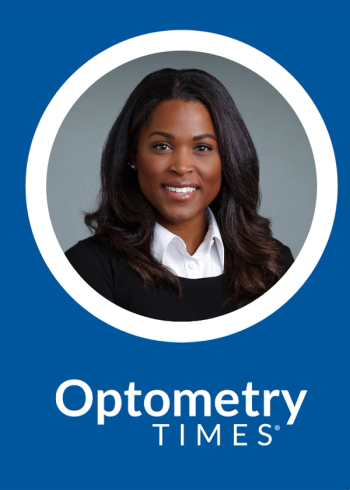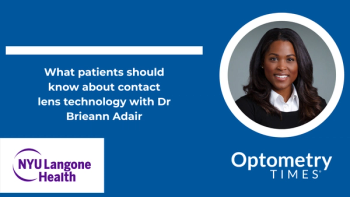
Transcript: Tips on fitting new Johnson & Johnson Vision multifocal contact lens
Two key points to remember when fitting
Gretchyn Bailey, NCLC, FAAO: Hi, everyone. I am Gretchyn Bailey with Optometry Times®, and today I have the pleasure of speaking with Danielle Richardson, OD, who is based in Los Angeles. Dr. Richardson, thank you so much for taking the time to talk with me today.
Danielle Richardson, OD: Thank you for having me.
Bailey: We are going to talk today about a new lens from Johnson & Johnson Vision (JJV). The company recently launched Acuvue Oasys Multifocal with Pupil Optimized Design. Can you tell me how you started to get involved with this lens and what your experiences are with it, how you are fitting it?
Dr. Richardson: Yes, absolutely. As a member of Johnson & Johnson’s consulting team, we were given early access to this lens. It was great to understand the optics behind the lens and the pupil optimized design and how that is going to help our patients be more comfortable in the lens. But being able to know that in theory and implement it in practice has been a really great experience.
I have fit the lens on a few patients, and we have had a lot of success. Many patients are coming to me looking for multifocal solutions because of increased Zoom time because everyone is spending more time at home on Zoom. People want to be glasses-free but also to be able to see clearly at that intermediate distance. I think this lens has provided a lot of success, in my opinion, in providing that clear vision for patients at the computer.
Pupil optimized design
Bailey: You make a good point about being on Zoom calls because I know that both you and I can attest to being on a bunch of Zoom calls. That intermediate distance is tough. So, can you tell me what does pupil-optimized design mean?
Dr. Richardson: Absolutely. Pupil-optimized design just means that the pupil size is taken into consideration in terms of lens design. Pupil size changes based on age and refractive error. The Acuvue Oasys Multifocal lens and the technology that is there, the pupil optimized design, varies based on the patient's age, and that is going to be the added power and the patient's refractive error. For example, a myopic patient is going to have a larger pupil than a hyperopic patient. A lens that is -6.00 D is going to have a different center zone of clarity than a lens that is +3.00 D. Those pupil zones of clarity, that pupil optimized-design, there is going to be a further consideration for the multifocal added power. All that to say what pupil optimized design means is that it accounts for the variance in pupil size in both refractive error and age or added prescription power. Each lens is customized to give each patient with a specific prescription the best multifocal vision possible.
Bailey: That was a good explanation. And I do know how pupil size can affect that, especially if we are talking bright light or later at night when your pupil expands or constricts. So, that is great news. How have your patients reacted to it, the ones who you have fit?
Dr. Richardson: They have been really happy.I have a patient who is about a -4.50 D. He is a myopic patient, 55 years old, wanting to get into multifocal contact lenses. He has previously just worn glasses. But again, the primary reason is that he is not liking the way the glasses, glare, and reflection are happening on Zoom. He wants to be able to be on Zoom without glasses. So, that was an excellent patient. I think, because he is a myope, he understands nearsighted vision and he understands the concept of distance and near clarity, we were able to fit him with a lens. We ended up with a medium and a high multifocal addition. I was able to successfully fit him in a lens.
The thing about Acuvue Oasys and Acuvue 1-Day Moist Multifocal technology is that if you follow the fit guide, you can fit those patients successfully 97% of the time in 2 visits or less. And this patient that I am speaking of, he is one of those patients. We were able to nail it after 2 modifications to the lens, and he was very, very happy with his computer vision. That is just 1 example.
I have another patient, again, who wants to be glasses-free, and we were able to get her into contact lenses that she can wear when she does her jobs on the weekend. So, patients have really responded very favorably to this lens, and I would say the real wow factor for me has been how successful it has been at that computer distance because that can always be tricky with multifocal designs. I think that is where this pupil-optimized design technology really has its advantages.
Patient pool
Bailey: That is good information to have. How do you suggest your optometric colleagues look to position this lens in their practices? Do they want to refit existing multifocal contact lens wearers? Are you looking for emerging presbyopes to get them involved? Is there a certain patient population that you recommend they look at?
Dr. Richardson: Yes, absolutely. I think you can look at any of your Acuvue Oasys patients, right? You have that existing pool of patients. We know Acuvue Oasys is one of the most popular contact lenses. So, you already have that existing patient pool of people who are currently doing distance only and wearing reading glasses, or maybe they are doing a modified monovision. You already have that existing group of presbyopes in Acuvue Oasys in your office.
Another key demographic is the emerging presbyopes, the people who are starting to just need reading glasses and being able to offer them a first-take solution, right? Well, what about using this contact lens, and that way, you don't have to carry readers around with you? Offer that to those emerging presbyopes because they may not have heard of this type of technology. They may not be aware of the lens, so just make them aware of it. Definitely the existing Acuvue Oasys presbyopes and those emerging presbyopes, or people just needing glasses for the first time.
Talk to your patients about their visual demands and how have things changed for them. Maybe they historically had at one type of job where multiple pairs of glasses were fine, or their progressive lenses were fine. Maybe things have changed in this post COVID-19 world for them. Maybe their work demands, maybe their visual demands have changed. I think just start to have the conversation about when would you like to be glasses-free? Would you like to be able to do all of your tasks without glasses? Those conversations. Just invite a person, invite your patients to start to think about a multifocal lens technology.
Fitting
Bailey: If you had 1 or 2 tips to offer your colleagues on fitting this lens, what would they be?
Dr. Richardson: My number 1 tip would be to make sure you use sensory eye dominance. A lot of times we use motor or sighting dominance where we have patients use their hands and tell us their dominant eye. That is great and can reveal information for us. However, that may not be the patient's true dominant eye. Doing that +1.00 D blur sensory dominance test is going to tell you which eye is going to be able to accept that plus power, and that is going to allow us to have a successful fit. So, step number 1 is use sensory eye dominance to make sure you have the right dominant eye.
Number 2 would be to have a new, fresh refraction and use the fitting guide in the fitting calculator. Johnson & Johnson has made it so easy with the Acuvue Oasys Multifocal lens. There is literally a calculator online. You can put in the person’s prescription, their age, their reading addition, and it will generate your first lens for you. It also goes alongside the fitting guide to tell you what modifications you need to make, if you need to improve distance or near clarity. It is super easy, and it is super simple for you to really wow your patients on that first bit without taking a lot of your time.
So, number 1, just make sure you use sensory eye dominance. That way you can have a note of what their true dominant eye is. And number 2, use your brand-new refraction, plug it in the calculator, and follow the fitting guide. Again, you will be in that group of 97% of the patients who are fit successfully in 2 visits or less. Really, that is what makes you their doctor. That is what is going to set you up to be successful.
I think so often doctors don’t talk to patients about what’s new, or what’s the latest and what’s the greatest. That is a missed opportunity for us to be subject matter experts and for our patients to hear about this from us first and not from consumer advertising.
Bailey: I think you are absolutely right. And those are 2 very good tips to offer other optometrists out there interested in fitting this new lens. So, Dr. Richardson, thank you so much for taking the time to talk with me today about this new lens, and I look forward to talking with you soon.
Dr. Richardson: I look forward to talking to you soon as well.
Newsletter
Want more insights like this? Subscribe to Optometry Times and get clinical pearls and practice tips delivered straight to your inbox.





